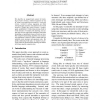ACL
2012
12 years 3 months ago
2012
For sentence compression, we propose new semantic constraints to directly capture the relations between a predicate and its arguments, whereas the existing approaches have focused...
ACL
2012
12 years 3 months ago
2012
We argue that multilingual parallel data provides a valuable source of indirect supervision for induction of shallow semantic representations. Specifically, we consider unsupervi...
ACL
2011
13 years 4 months ago
2011
Standard algorithms for template-based information extraction (IE) require predefined template schemas, and often labeled data, to learn to extract their slot fillers (e.g., an ...
COLING
2010
13 years 8 months ago
2010
This paper analyzes the contribution of semantic roles to TimeML event recognition and classification. For that purpose, an approach using conditional random fields with a variety...
EMNLP
2009
13 years 10 months ago
2009
Semantic Role Labeling (SRL) has proved to be a valuable tool for performing automatic analysis of natural language texts. Currently however, most systems rely on a large training...
EMNLP
2009
13 years 10 months ago
2009
Most existing systems for Chinese Semantic Role Labeling (SRL) make use of full syntactic parses. In this paper, we evaluate SRL methods that take partial parses as inputs. We fir...
ACL
2009
13 years 10 months ago
2009
A number of studies have presented machine-learning approaches to semantic role labeling with availability of corpora such as FrameNet and PropBank. These corpora define the seman...
ACL
2009
13 years 10 months ago
2009
We describe an unsupervised system for learning narrative schemas, coherent sequences or sets of events (arrested(POLICE,SUSPECT), convicted( JUDGE, SUSPECT)) whose arguments are ...
NAACL
2010
13 years 10 months ago
2010
Semantic role labeling (SRL) not only needs lexical and syntactic information, but also needs word sense information. However, because of the lack of corpus annotated with both wo...
EMNLP
2010
13 years 11 months ago
2010
In many NLP systems, there is a unidirectional flow of information in which a parser supplies input to a semantic role labeler. In this paper, we build a system that allows inform...






